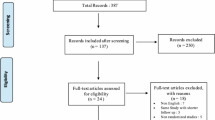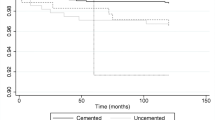Abstract
Purpose
Hip resurfacing arthroplasty has gained popularity for treating young and active patients who have arthritis. There are two major data sources for assessing outcome and revision rate after total joint arthroplasty: sample-based clinical trials and national arthroplasty registers. The purpose of this study was to evaluate the outcome of the Birmingham Hip Resurfacing (BHR) arthroplasty in terms of revision rate as reported in clinical studies and recorded by national arthroplasty registers.
Methods
A comprehensive literature research was performed from English-language, peer-reviewed journals and annual reports from national joint arthroplasty registers worldwide. Only publications from MEDLINE-listed journals were included. The revision rate was used as the primary outcome parameter. In order to allow for direct comparison of different data sets, calculation was based on revisions per 100 observed component years. For statistical analysis, confidence intervals (CI) were calculated.
Results
A total of 18,708 implants, equivalent to 106,565 observed component years, were analysed in the follow-up studies. The register reports contained 9,806 primary cases corresponding to 44,294 observed component years. Statistical analysis revealed a significant difference in revisions per 100 observed component years between the development team (0.27; CI: 0.14–0.40) and register data (0.74; CI: 0.72–0.76).
Conclusion
The BHR arthroplasty device shows good results in terms of revision rate in register data as well as in clinical studies. However, the excellent results reported by the development team are not reproducible by other surgeons. Based on the results of our study, we believe that comprehensive national arthroplasty registers are the most suitable tool for assessing hip arthroplasty revision rate.



Similar content being viewed by others
References
Ollivere B et al (2010) The Birmingham Hip Resurfacing: 5-year clinical and radiographic results from a District General Hospital. Int Orthop 34(5):631–634
McMinn DJ et al (2011) Indications and results of hip resurfacing. Int Orthop 35(2):231–237
McMinn DJ et al (2008) Results of the Birmingham Hip Resurfacing dysplasia component in severe acetabular insufficiency: a six- to 9.6-year follow-up. J Bone Joint Surg Br 90(6):715–723
Mont MA et al (2006) Hip resurfacing arthroplasty. J Am Acad Orthop Surg 14(8):454–463
Labek G, Janda W, Agreiter M, Schuh R, Böhler N (2011) Organisation, data evaluation, interpretation and effect of arthroplasty register data on the outcome in terms of revision rate in total hip arthroplasty. Int Orthop 35(2):157–163, Epub 2010 Oct 5
Labek G, Stoica CI, Boehler N (2008) Comparison of information in arthroplasty Registers from different countries. J Bone Joint Surg Br 90-B:288–291
Schuh R et al (2011) Validity of published outcome data concerning Anatomic Graduated Component total knee arthroplasty: a structured literature review including arthroplasty register data. Int Orthop. Apr 13. [Epub ahead of print]
Aulakh TS et al (2010) Hip resurfacing and osteonecrosis: results from an independent hip resurfacing register. Arch Orthop Trauma Surg 130(7):841–845
Back D, Dalziel R, Young D, Shimmin A (2004) Early results of primary Birmingham hip resurfacings. An independent prospective study of the first 230 hips. J Bone Joint Surg Br 87(3):324–329
Baker RP et al (2011) A medium-term comparison of hybrid hip replacement and Birmingham hip resurfacing in active young patients. J Bone Joint Surg Br 93(2):158–163
Bose VC, Baruah BD (2010) Resurfacing arthroplasty of the hip for avascular necrosis of the femoral head: a minimum follow-up of four years. J Bone Joint Surg Br 92(7):922–928
Carrothers AD et al (2010) Birmingham hip resurfacing: the prevalence of failure. J Bone Joint Surg Br 92(10):1344–1350
Cooke NJ et al (2009) Bone density of the femoral neck following Birmingham hip resurfacing. Acta Orthop 80(6):660–665
Daniel J, Pynsent PB, McMinn DJ (2004) Metal-on-metal resurfacing of the hip in patients under the age of 55 years with osteoarthritis. J Bone Joint Surg Br 86(2):177–184
De Smet K (2005) Belgium experience with metal-on-metal surface arthroplasty. Orthop Clin North Am 36(2):203–213
Giannini S (2007) Hip resurfacing mid term results of the last generation metal-on-metal devices. J Orthop Traumatol 8:202–206
Heilpern GN, Shah NN, Fordyce MJ (2008) Birmingham hip resurfacing arthroplasty: a series of 110 consecutive hips with a minimum five-year clinical and radiological follow-up. J Bone Joint Surg Br 90(9):1137–1142
Hing C, Back D, Shimmin A (2007) Hip resurfacing: indications, results, and conclusions. Instr Course Lect 56:171–178
Khan M et al (2009) Birmingham hip arthroplasty: five to eight years of prospective multicenter results. J Arthroplasty 24(7):1044–1050
Langton DJ et al (2011) Adverse reaction to metal debris following hip resurfacing: the influence of component type, orientation and volumetric wear. J Bone Joint Surg Br 93(2):164–171
Madhu TS et al (2011) The Birmingham hip resurfacing prosthesis: an independent single surgeon’s experience at 7-year follow-up. J Arthroplasty 26(1):1–8
Marulanda GA et al (2008) Early clinical experience with the use of the Birmingham hip resurfacing system. Orthopedics 31(12 Suppl 2)
McAndrew AR et al (2007) A district general hospital’s experience of hip resurfacing. Hip Int 17(1):1–3
McBryde CW et al (2008) Metal-on-metal hip resurfacing in developmental dysplasia: a case–control study. J Bone Joint Surg Br 90(6):708–714
McBryde CW et al (2010) The influence of head size and sex on the outcome of Birmingham hip resurfacing. J Bone Joint Surg Am 92(1):105–112
Nishii T et al (2007) Five-year results of metal-on-metal resurfacing arthroplasty in Asian patients. J Arthroplasty 22(2):176–183
Ollivere B et al (2009) Early clinical failure of the Birmingham metal-on-metal hip resurfacing is associated with metallosis and soft-tissue necrosis. J Bone Joint Surg Br 91(8):1025–1030
Pollard TC et al (2006) Treatment of the young active patient with osteoarthritis of the hip. A five- to seven-year comparison of hybrid total hip arthroplasty and metal-on-metal resurfacing. J Bone Joint Surg Br 88(5):592–600
Reito A, Puolakka T, Pajamaki J (2010) Birmingham hip resurfacing: Five to eight year results. Int Orthop 35(8):1119–1124
Steffen RT et al (2008) The five-year results of the Birmingham Hip Resurfacing arthroplasty: an independent series. J Bone Joint Surg Br 90(4):436–441
Swank ML, Alkire MR (2009) Minimally invasive hip resurfacing compared to minimally invasive total hip arthroplasty. Bull NYU Hosp Jt Dis 67(2):113–115
Treacy R, McBryde CW, Pynsent PB (2005) Metal-on-metal resurfacing of the hip in patients under the age of 55 years with osteoarthritis. J Bone Joint Surg Br 86(2):177–184
Treacy RB et al (2011) Birmingham hip resurfacing: a minimum follow-up of ten years. J Bone Joint Surg Br 93(1):27–33
Witzleb WC et al (2009) In vivo wear rate of the Birmingham Hip Resurfacing arthroplasty. A review of 10 retrieved components. J Arthroplasty 24(6):951–956
Mcbryde C, Revell MP, Thomas AM, Treacy RB, Pysent PB (2008) The Influence of Surgical Approach on Outcome im BHR. Clin Orthop Relat Res 466:920–926
Malek I, Hashmi M, Holland JP (2010) Socio economic impact of Birmingham hip resurfacing on patient employment after ten years. Int Orthop. Epub ahead of print (Nov. 27)
Doll R, Hill AB (1956) Lung cancer and other causes of death in relation to smoking. A second report on the mortality of Brithish doctors. BMJ 10(5001):1071–1081
Lilienfeld A, Lilienfeld DE (1980) Foundations of epidemiology, second edition. Oxford Univ. Press, p. 245
Australian Orthopaedic Association (2010) Hip and knee arthroplasty annual report. Joint Repplacement Registry
New Zealand Orthopaedic Association (2009) Annual report. New Zealand Joint Arthroplasty Register
Danish Hip Arthroplasty,Register (2009) Annual report http://www.dhr.dk/ENGLISH.htm
Danish Knee Arthroplasty Register (2009) Annual report. http://www.knee.dk, 2009
Vail TP (2004) Hip resurfacing. J Am Acad Orthop Surg 19(4):236–244
McGrory B et al (2010) Modern metal-on-metal hip resurfacing. J Am Acad Orthop Surg 18(5):306–314
Swedish National Hip Arthroplasty Register (2008) Annual report. http://www.jru.orthop.gu.se
Labek G et al (2009) High failure rate of the Duraloc Constrained Inlay. Acta Orthop 80(5):545–547
Labek G et al (2011) Outcome of the cementless Taperloc stem: a comprehensive literature review including arthroplasty register data. Acta Orthop 82(2):143–148
Labek G et al (2011) Outcome and reproducibility of data concerning the Oxford unicompartmental knee arthroplasty: a structured literature review including arthroplasty registry data. Acta Orthop 82(2):131–135
Labek G, Stoica CI, Bohler N (2008) Comparison of the information in arthroplasty registers from different countries. J Bone Joint Surg Br 90(3):288–291
Labek G et al (2011) Revision rates after total ankle arthroplasty in sample-based clinical studies and national registries. Foot Ankle Int 32(8):740–745
Author information
Authors and Affiliations
Corresponding author
Rights and permissions
About this article
Cite this article
Schuh, R., Neumann, D., Rauf, R. et al. Revision rate of Birmingham Hip Resurfacing arthroplasty: comparison of published literature and arthroplasty register data. International Orthopaedics (SICOT) 36, 1349–1354 (2012). https://doi.org/10.1007/s00264-012-1502-0
Received:
Accepted:
Published:
Issue Date:
DOI: https://doi.org/10.1007/s00264-012-1502-0




